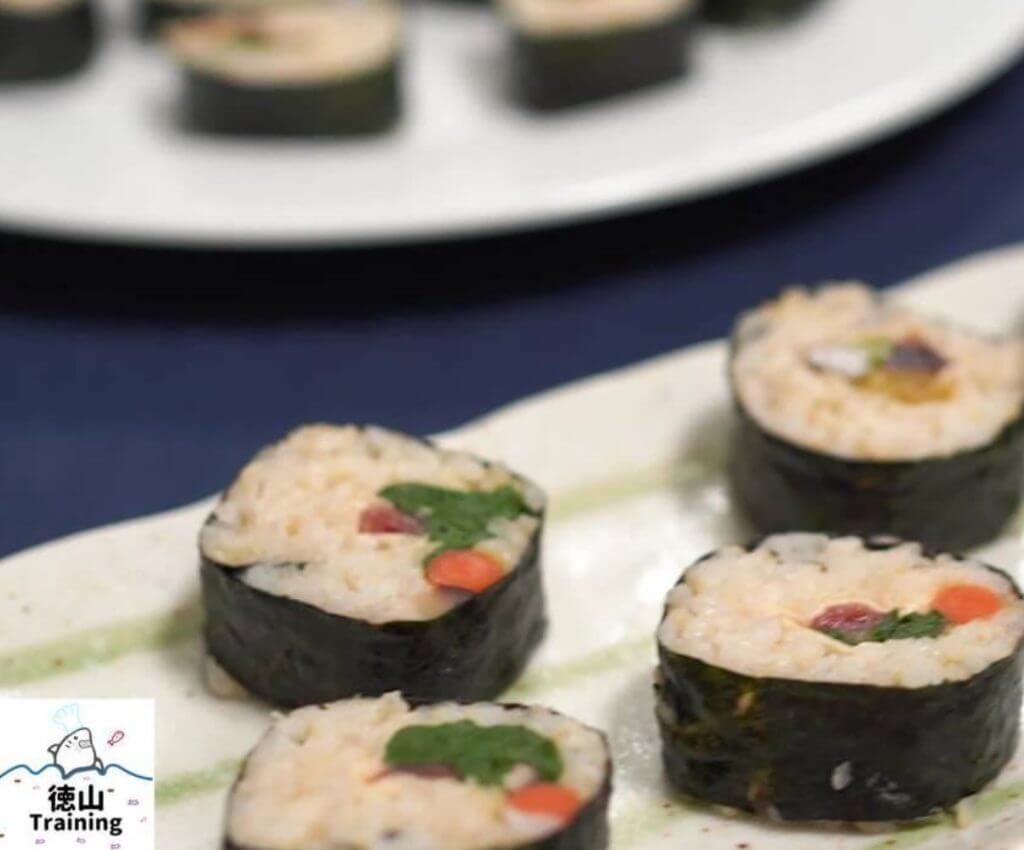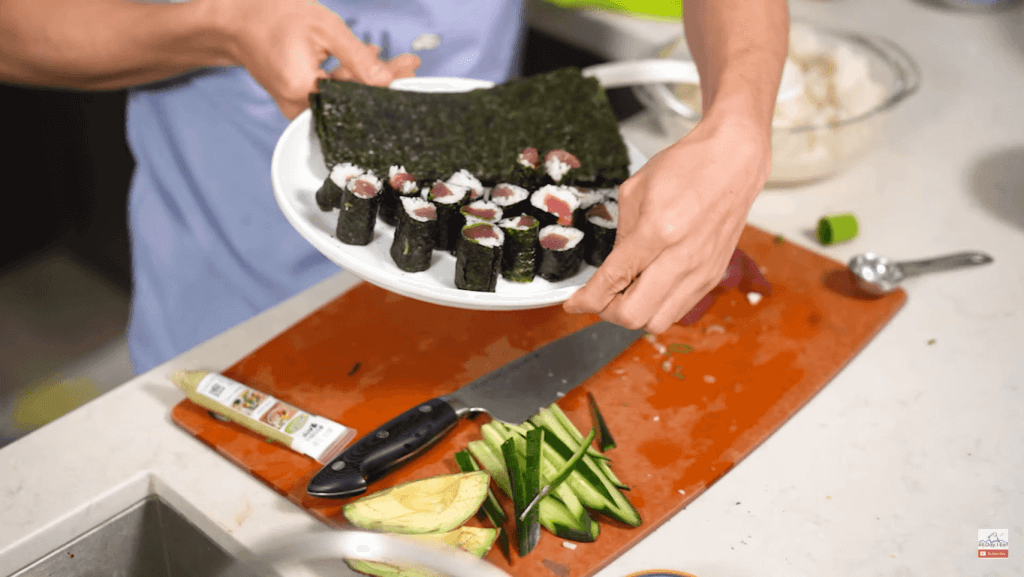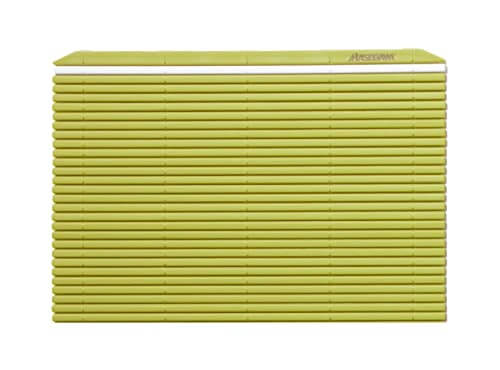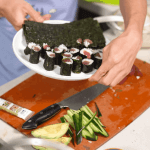Today, we are making a very simple dinner using sashimi! I have some tuna, and we’re going to be making makizushi, tekkamaki, which is one of my favorites (the tuna roll). We’ll also do kappamaki and some avocado.

What is makizushi?
Makizushi is a type of sushi that is rolled using nori seaweed sheets and has various fillings.
You can put a lot of things in makizushi.
Tuna (tekkamaki), for example.
You can also put cucumbers(kappamaki), natto (natto maki), and other types of fillings.
In Japanese, Maki means to roll, zushi is the word for sushi!
The sushi rolls get their shape in part due to the specialized tool used to make them.
It’s call a makisu.
You can get both bamboo and plastic versions (i have the green one above) if you want to try making the makizushi at home.
It’s pretty easy and very satisfying if you haven’t tried yet.

What is natto?
Natto is fermented soybeans.
If you’ve never seen it before, it comes like this in a little foam packet.
A lot of times, it’s frozen. You can actually make it at home if you don’t have a market near you.
You just need the natto starter, which you can get on Amazon, by the way.
It’s actually pretty easy to make at home – especially if you have a yogurt maker.
It’s a little bit stinky because it’s fermented soybean, obviously.
If you’re buying premade natto, it usually comes with sauce packets.
These are also known as ‘tare’, the Japanese word for liquid seasoning.
Sometimes the natto also comes with karashi, or japanese mustard. (which i dislike very much! ha )

Tips for making the best sushi rice
- Sushi rice is traditionally made with short grain Japanese rice, which is a type of rice that is sticky and holds its shape well.
- Rinse the rice in cold water several times before cooking to remove excess starch and dirt. This will help the rice cook evenly and prevent it from becoming too sticky.
- When making sushi rice, don’t skip on the konbu. This humble ingredient is packed with umami and adds a unique and unmistakable japanese flavor to your sushi rice.
- Fold your rice when seasoning it with sushi vinegar so you don’t squish the cooked grains together, which would not be good!
- Season the rice while the rice is hot.
- While mixing the vinegar mixture, use a fan or a large piece of paper to fan the rice and cool it down quickly. This will prevent the rice from becoming too mushy.
- allow the rice to cool to room temperature before using.
- Keep covered if not using right away.
Tips for making the makizushi, successfully the first time!
- Wet your hands slightly when handling and making the sushi rolls.
- Be sure to also wet the knife you’ll be using to cut up the sushi rolls, wiping it in between with a very wet towel so the rice doesnt stick.
- Always use fresh ingredients, especially if you’re using raw fish!
- Use a sushi mat (makisu)!
- If you don’t want to roll your sushi, an easier way to enjoy sushi is to just make a hand roll
- Be gentle with the rice, you dont want to squish it.
- be patient, sometimes it takes a little practice (as you can see, i’m not really a perfectionist with my rolls :o)
(temakizushi) or layer a bed of sushi rice and top with fish or desired vegetables (chirashizushi).
Tips for improving flavor of your makizushi
- Add a bit of wasabi and pickled ginger (gari). want to know how to make your own gari? discover how simple and delicious it is in my otsukemono workshop
- try some makizushi variations, that are simple to make:
-add toasted sesame seeds to the cucumber roll (kappamaki)
-add finely chopped green onion to the natto roll (natto maki)
-add thinly sliced avocado, or cucumber, or kaiware daikon (daikon radish sprouts), or shiso leaves to the tuna roll. - use a good quality japanese soy sauce. not sure what good quality is? look for these things on the label:
- product of japan
- organic
- ingredients : soy beans, water, salt
- optional: saishikomi or twice brewed soy sauce for a more mellow flavor
- You can even include all of the above! (but it might be a really fat sushi roll)
And yes, there really is a fat sushi roll called ‘futomaki’ which sometimes has over 7 different ingredients. Common ingredients include tamagoyaki (sweet omelette), kampyo (dried gourd), cucumber, umeboshi (pickled plum), and natto, as well as fish and other seafoods.
Futomaki is often enjoyed during the Japanese holiday of Setsubun, which is celebrated in February, as it is believed to bring good luck. Additionally, it is a popular dish during the Children’s Day in Japan and other celebrations.
It’s usually cut into smaller bite-sized pieces to be shared and usually served with soy sauce and wasabi as dipping sauce.
See image below from what we made in the sushi workshop!

Have you ever made makizushi at home before?
Let me know in the comments below!
This is one of the easiest things that you can make.
And it goes great with miso soup!
If you haven’t tried making miso soup before, you can find the recipe here.
Printhow to make makizushi | homemade sushi rolls with tuna, natto and cucumber (kappamaki)
Makizushi is a type of sushi that is rolled using nori seaweed sheets and has various fillings.
Ingredients
For the sushi rice:
- Sushi rice vinegar ((liquid or powdered version))
- 2 cups uncooked (rice)
- 2 pieces 1-inch kombu
- sugar/ salt ((optional: only of you want the rice sweeter/saltier))
Sushi fillings:
Instructions
For the sushi rice:
- Add kombu when you’re cooking your rice for extra umami flavor (optional).
- Refer to your sushi rice vinegar instructions for the rice to vinegar ratio (mine was 5 tbsp sushi vinegar for 2 cups of uncooked rice).
- Gently fold the sushi vinegar into the rice. (Do it gently so you don’t squish the cooked rice).
- Add salt or sugar if preferred (optional).
- Set aside.
Preparing the nori sheets and sushi rice:
- Cut the nori sheets into half.
- Place one sheet on top of the makisu (or sushi mat).
- Spread a thin layer of sushi rice on top of the nori sheet.

- Smear wasabi on top of the rice (optional).
- Repeat this procedure as many times as you need.
Preparing the filling- Tuna (Tekkamaki):
- Cut the tuna into long, thin strips (about ¼ – ½-inch thick).

- Place a strip of sliced tuna on top of the rice.
- Place shiso leaves on top of rice and tuna (optional).
- Using the makisu (sushi mat), gently, but firmly roll up the sheet until it looks like a tube.
- Using a wet, sharp knife, cut up the tuna maki rolls into smaller parts like so:
Kappamaki (cucumber maki):
- Cut the cucumbers into long, thin strips.
- Place sliced cucumbers on top of the rice.

- You can sprinkle some toasted sesame seeds on top of the rice, but it’s optional.
- Using the makisu (sushi mat), gently, but firmly roll up the sheet until it looks like a tube.
- Using a wet, sharp knife, cut up the sushi rolls.
For the natto-onion mixture
- Empty the 3 natto packets into a bowl
- Add in the tare(the seasoning that comes with the natto)
Note: If your natto packets don’t come with tare, just use regular soy sauce.
- Add in some finely-chopped green onion (the amount depends on your preference).
- Mix together.
- Smear the natto-onion mixture on top of the rice
- Using the makisu (sushi mat), gently, but firmly roll up the sheet until it looks like a tube.
- Using a wet, sharp knife, cut up the sushi rolls.
















Konnichiwa! (Hello!) I'm Pat Tokuyama, a Japanese tofu cookbook author, who travels for music, food, and adventure. If you like Japanese tea, checkout some of the newestorganic japanese tea, matcha bowls and noren and more!
** Curious about the Plant Based Japanese Cooking Club? ** Learn more here!